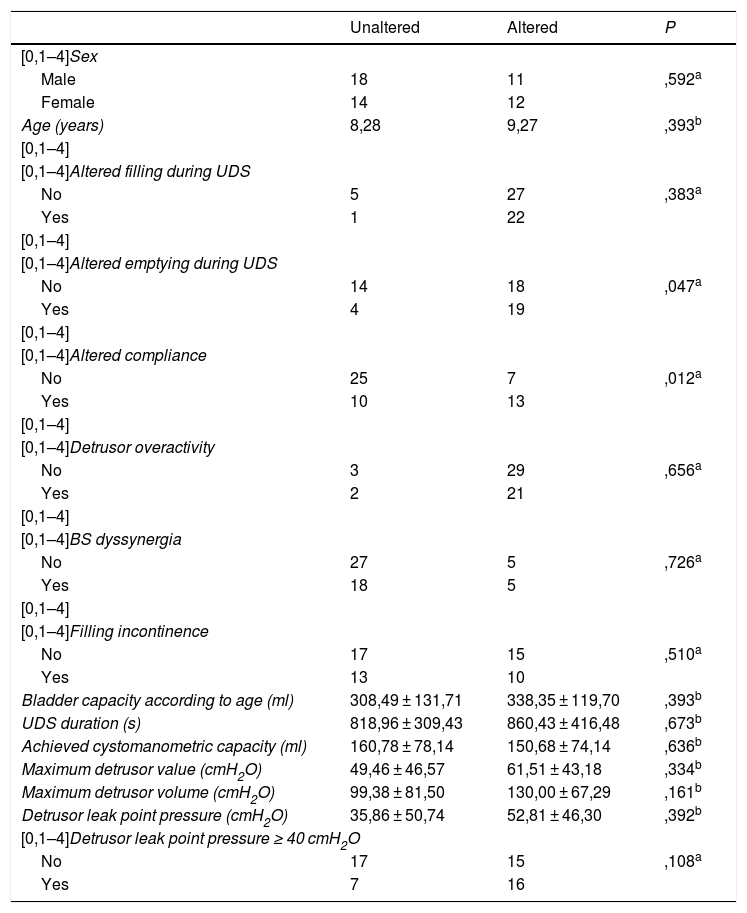Neuropathic bladder (NB) is a lower urinary tract dysfunction (LUTD) that may lead to kidney failure. Urodynamic study is the gold standard for its diagnosis and follow-up. A classic prognostic parameter to predict the risk of upper urinary tract damage (UUTD) is the detrusor leak point pressure (DLPP) ≥ 40 cmH2O, although this factor alone may lack prognostic value. The area under the curve (AUC) of the detrusor pressure tracing has been recently described as a prognostic factor.
AimTo analyze the clinical utility of the AUC of the detrusor pressure tracing in the pediatric population (<15 years).
MethodsRetrospective study of urodynamic recordings in pediatric population with NB from 2011 to 2020. The following variables were evaluated: detrusor leak point pressure ≥ 40 cmH2O, voiding dysfunction, bladder compliance and overactivity. The sample is classified according to clinical-radiological findings at the time of the UD. AUC is calculated using Newton-Cotes rules (trapezium, Simpson’s rule) and its indexes are calculated according to bladder capacity (TI: Trapezium Index, SI: Simpson Index). Statistical significance: P < .05.
ResultsFifty-five recordings are analyzed. Unfavorable clinical condition was identified in 41.8% (n = 23) patients. Voiding dysfunction, low compliance and both indexes were associated with an unfavorable clinical condition (P < .05). ROC analysis showed the following AUC for the new indexes: TI (0.736, P = 0.0006), SI (0.755, P = .0001) with a cut-off value of 10,69 and 8 cmH2O·s/cc, respectively. We did not find differences in the diagnostic performance between them (P > .05).
ConclusionsThe analyzed indexes are useful in the diagnosis of patients with NB and unfavorable clinical condition.
La vejiga neuropática(VN) es una disfunción del tracto urinario inferior(DTUinf) con riesgo de deterioro de la función renal, siendo el estudio urodinámico(EUD) la prueba patrón para su diagnóstico y seguimiento. El parámetro urodinámico clásico para identificar el riesgo renal es la presión de fuga del detrusor ≥ 40 cmH2O, aunque este valor aislado puede carecer de interés pronóstico. Recientemente se ha descrito el área bajo la curva (ABC) del trazado de la presión del detrusor como factor pronóstico.
ObjetivoAnalizar la utilidad clínica del ABC del trazado de la presión del detrusor en edad pediátrica (<15 años).
MétodosEstudio retrospectivo de registros urodinámicos en población pediátrica con VN entre 2011–2020. Se registran: presión detrusor y de fuga ≥ 40 cmH2O, alteración de la acomodación, vaciado e hiperactividad detrusor. Se clasifica la muestra según evolución clínica-radiológica en el momento del EUD. Se calcula el ABC utilizando los métodos de Newton-Côtes(trapecios, Simpson compuesto) y se calculan sus índices según la capacidad vesical(IT:Índice Trapecios; IS:Índice Simpson). Significación estadística: P < ,05.
ResultadosSe analizan 55 registros. El 41,8% (n = 23) tuvo una evolución clínica desfavorable. La alteración en el vaciado, la hipoacomodación y los índices se asociaron a una situación clínica desfavorable (P < ,05). El ABC del rendimiento diagnóstico de los nuevos índices fue: IT (0,736, P = ,0006); IS (0,755, P = ,0001). Los puntos de corte del valor de IT e IS fueron de 10,69 y 8 cmH2O·s/cc, respectivamente. No encontramos diferencias en el rendimiento diagnóstico entre ellos (P > ,05).
ConclusionesLos nuevos índices estudiados son útiles en el diagnóstico de pacientes con VN y situación clínica desfavorable.












